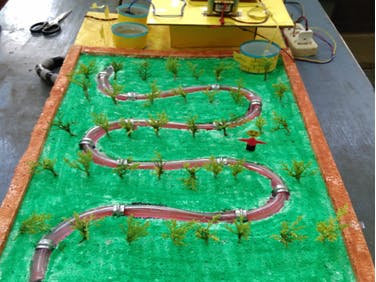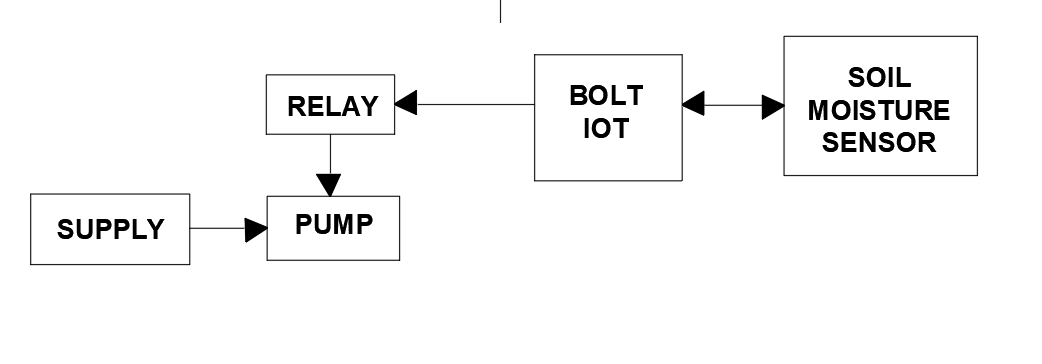ABSTRACT:
Irrigation motor control and monitoring. we are using a Bolt IoT device in this project and soil moisture sensor, this project is used to sense or measure the moisture content in the soil. the soil moisture sensor is a sensor which varies the value when it contacts the moisture. basically it is a resistor that works on moisture condition. when the moisture is more then the value of resistance will decrease and when the moisture is less then the resistance value is more. Information from the sensors of the motor is regularly updated through Twilio is a cloud communications platform as a service (CPaaS) allows software developers to programmatically make and receive phone calls, send and receive text messages, and perform other communication functions using its web service APIs.
WORKING PRINCIPLE:
Irrigation motor control and monitoring system using Bolt IOT is used tor irrigate the land where the soil is in dry condition and when the land is irrigated properly the motor shuts down automatically. This happens with the help of soil moisture senor.
firstly the threshold values are fixed for drought condition up to max value that is fully dry agricultural land. Then the land conditions is continuously monitored whether it may be wet or dry by soil moisture sensor and the data is send to the Bolt Cloud, Based on the API keys and all the details of conf.py file the details are displayed and run on Ubuntu server and also it requests SMS request to twilio cloud service.
COMPONENTS USED:
All the components required for the project are mentioned below and are easily available in market at reasonable price.
HARDWARE REQUIREMENTS:
1. Soil moisture Sensor:
soil moisture sensor is used to mesure the soil moisture content in the agricultural land and alert the user and also correspondingly drives the relay and make the motor on and off.
2. Bolt IoT:
Bolt IoT is the Core device used in this Project, which handels the control signals to the components connected to it and its cloud.
3. Relay Module:
Relay module is used as a driver circuit for the motor or the pump to be operated.
4. Pump:
Pump is used to extract the water from the well and irrigate the agricultural land.
5. Transformer:
Transformer is used to convert the 230V supply to 24V to give the supply to the pump.
6. Jumper wires:
Used for connection purpose.
SOFTWARE REQUIREMENTS:
BoltIOT Platform:
Bolt IoT platform gives you the capability to control your devices and collect data from IoT devices safely and securely no matter where you are. Get actionable insights by deploying machine learning algorithms with just a few clicks to detect anomalies as well as predict sensor values. To know more visit boltiot.com.
In the previous lesson, we created our account on Bolt Cloud. Before we link our Bolt device to our account, let us understand the Bolt Cloud Architecture, how it works, and why it is important.
The Bolt Cloud is one of the major component in providing the IoT capabilities to the Bolt device. All the Bolt devices connect to the Bolt Cloud out of the box. The Bolt devices are shipped with a firmware that helps it understand how to connect to the Bolt Cloud over the Internet.
Communication of Bolt Devices with Bolt CloudThe communication of Bolt devices with Bolt Cloud happens over the MQTT communication protocol. MQTT stands for Message Queue Telemetry Transport. But why do we need to have a protocol such as MQTT for communication when HTTP & HTTPS protocols are so popular and widely used for communication? Although these protocols are popular, the amount of overhead data that is sent over the Internet for managing the communication is quite a lot. Overhead data is the data which is sent along with the actual message/data which conveys the extra information required to understand the message/data sent. The overhead data varies from protocol to protocol. This is fine in case of systems such as mobile phones, laptops, desktop computes that have the hardware capabilities and the network capabilities to send the extra overhead data.
Most IoT devices and sensors contain limited processing capabilities and constrained Internet bandwidth. Due to these limitations, they send data over the Internet only when required and the data sent is very low in terms of bandwidth usage. Hence using protocols such as HTTP, HTTPS does not become feasible where the overhead data is more than the actual data itself. MQTT contains very low overhead and hence becomes ideal for IoT communication.
MQTT is a pub-sub messaging protocol. Pub refers to publishing and sub refers to subscribing. There is a central entity, in our case it is the Bolt Cloud. All the Bolt devices connect to the Bolt Cloud and send the data to various channels by publishing the data on their unique channels. The Bolt devies also subscribe to channels so that they can receive commands coming from the Bolt users.
The Bolt Cloud users i.e. people like us communicate with the Bolt Cloud using the HTTPS communication protocol. We can use the Bolt Cloud dashboard to control and monitor our Bolt devices or use the Bolt Cloud APIs in case we want to by-pass the dashboard and access our Bolt devices via programs that we have written. We shall learn more about this in the next modules.
Bolt Cloud receives all the commands to control or request for sensor data from Bolt devices, and sends the commands to the Bolt device. The Bolt device executes the commands, and sends a response back to the Bolt Cloud which in turn forwards it to the user who initiated the command.
In this lesson, we understood the architecture of the Bolt Cloud, how the Bolt devices and users communicate with the Bolt Cloud. In the next lesson, we shall see how the Bolt Cloud works.
Twilio:
Twiliois a cloud communications platform as a service (CPaaS) allows software developers to programmatically make and receive phone calls, send and receive text messages, and perform other communication functions using its web service APIs.
Twilio uses Amazon Web Services to host telephony infrastructure and provide connectivity between HTTP and the public switched telephone network (PSTN) through its APIs.
Twilio follows a set of architectural design principles to protect against unexpected outages, and received praise for staying online during the widespread Amazon Web Services outage in April 2011.
Twilio supports the development of open-source software and regularly makes contributions to the open-source community. In June 2010 Twilio launched Open VBX, an open-source product that lets business users configure phone numbers to receive and route phone calls. One month later, Twilio engineer Kyle Conroy released Stash board, an open-source status dashboard written in the Python programming language that any API or software service can use to display whether their service is functioning properly. Twilio also sponsors Local tunnel, created by now ex-Twilio engineer Jeff Lindsay, which enables software developers to expose their local development environment to the public internet from behind a NAT
Creating and setup of twillo account:
Reference link: https://support.vision6.com.au/hc/en-us/articles/230673727-Text-Messaging-Account-Setup-with-Twilio
MODEL OF THE PROJECT:
Here the model is made and for the soil purpose I have used 2 glasses one with dry soil and one with wet soil and thus completed the project.












Comments